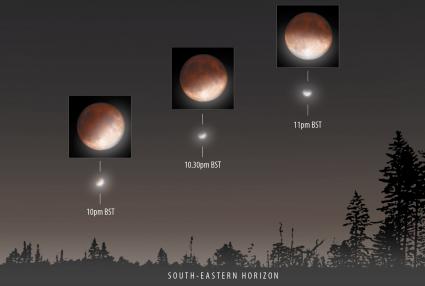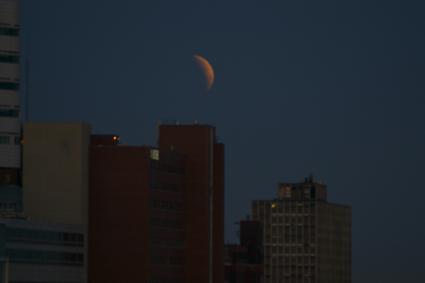Tuesday 16 July will see a partial eclipse of the Moon, visible in the UK after sunset. The eclipse, 50 years to the day after the launch of Apollo 11, will also be seen across a large part of Asia, the whole of Africa, the eastern part of South America, and the western part of Australia.
In a lunar eclipse, the Earth, Sun, and Moon are almost exactly in line and the Moon is on the opposite side of the Earth from the Sun. The Moon is full, moves into the shadow of the Earth and dims dramatically but usually remains visible, lit by sunlight that passes through the Earth’s atmosphere.
Stronger atmospheric scattering of blue light means that the light that reaches the lunar surface is predominantly red in colour, so for observers on Earth the eclipsed part of the Moon may be brick-coloured, rusty, blood red, or sometimes dark grey, depending on terrestrial conditions.
The Moon travels to a similar position every month at Full Moon, but the tilt of the lunar orbit means that it normally passes above or below the terrestrial shadow and no eclipse takes place.
In the coming eclipse, people in the UK will see the Moon rise in the south-eastern sky shortly after entering the darkest part of the Earth’s shadow, the umbra. Moonrise is at 2107 BST in London, at 2149 BST in Glasgow, and later further north and west. At moonrise the partially eclipsed Moon will be visible on the horizon in the southeast.
Sunset in London that day will be 2111 BST, and in Glasgow at 2152 BST, so the Moon will initially be seen in a bright twilight sky, in front of the stars of the constellation of Sagittarius. As the eclipse progresses more of the lunar surface will be in the darker shadow, with the remainder likely having a yellowish hue resulting from the lighter terrestrial shadow or penumbra.
Mid-eclipse is at 2230 BST, when about 60% of the visible surface of the Moon will be covered by the umbra. The Moon leaves the darker shadow at midnight, and the eclipse ends when it exits the penumbra 79 minutes later.
In the UK, the Moon will be low throughout the eclipse, so watching it will need an unobstructed south-eastern and southern horizon. But unlike a solar eclipse, the eclipsed Moon is completely safe to look at with the naked eye, so can be enjoyed as a free and beautiful astronomical spectacle.
Media contacts
Dr Morgan Hollis (available for interview – in York)
Deputy Press Officer
Royal Astronomical Society
Mob: +44 (0)7802 877 700
press@ras.ac.uk
Dr Robert Massey (available for interview – in London, then Bristol)
Deputy Executive Director and Press Officer
Royal Astronomical Society
Tel: + 44 (0)20 7292 3979
Mob: +44 (0)7802 877 699
press@ras.ac.uk
Further information
- The Royal Observatory Greenwich will be streaming a live feed of the event. For full details contact their press team at Press@rmg.co.uk
- HM Nautical Almanac Office eclipse website
- HM Nautical Almanac Office: Partial Eclipse of the Moon of 16 July 2019
- Astronomy Now: Don’t miss Tuesday night’s partial lunar eclipse
Notes for editors
The Royal Astronomical Society (RAS), founded in 1820, encourages and promotes the study of astronomy, solar-system science, geophysics and closely related branches of science. The RAS organizes scientific meetings, publishes international research and review journals, recognizes outstanding achievements by the award of medals and prizes, maintains an extensive library, supports education through grants and outreach activities and represents UK astronomy nationally and internationally. Its more than 4,000 members (Fellows), a third based overseas, include scientific researchers in universities, observatories and laboratories as well as historians of astronomy and others.
Follow the RAS on Twitter, Facebook, Instagram and YouTube



